My comments from tutorials, the heading Parametric potential are my comments later for what potential I see to test things in GC. This was not communicated to the students at the tutorial, but are my later reflections.
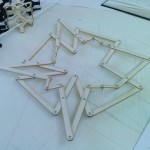
Haen Suk Yi
New auxetic structure, tried to develop control mechanism for overall system, but dropped it. aw
A1 still technical description of new auxetic part, and not conclusive. No architectural scale drawings.
– Must draw architectural performance (as ambition); spatial, climate control, structure, program) to scale
– Consider composite materials, not one that solves all
– Develop “control system” for auxetic components
Parametric potential
Should look at control mechanisms for overarching framework rather than try to do functioning component that simulates the auxetic principles for each “cube”. In this way, it is more interesting to see the effects of expanding / contracting local deformations, and their architectural performance, than to once again simulate the auxetic principles of the single unit, which would be necessary to do by reverse engineering the geometrical principles behind the deformation. Include parametric approach in design research statement.
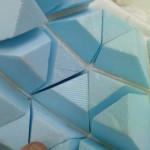
Kwan Joo Park
Models in too small scale
No A1 presentations for tutorial. No architectural scale drawings.
Adapted models from before. 3 axis or two axis?
Looked at Granite project from previous dip16 work (Dan Marks), pushed to think about what are the disadvantages of that project, how can it be improved?
Still wants to push maximum possibilities in system.
Steel wire mesh with loose nodes are opening up possibilities.
Wants to cut down 3 axis to 1 axis strips for transportation.
Different models are not connected. There is a strong conceptual progress, but little progress in making. Anything can be done in a factory, difficulty is assembly on site.
– Make use of variation from fabrication
– Must draw architectural performance (as ambition); spatial, climate control, structure, program) to scale
– Check British Concrete Association for issues of prefabrication
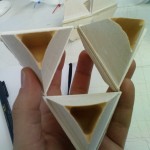
Parametric potential
The performance of controlling curvature of system on site in relation to components (suggesting deformation in a malleable structure prior to casting)? The effect of differentiation of components (they are currently all the same), and how this alters form? This can actually become a parametric reverse-engineering principle working in the standard GC way and for once making good use of the population principles. The key would be to be able to define the constraints in the form of the component: Only planar elements? Max/min angles of component sides? Exact location of reinforcement bars? Include parametric approach in design research statement.
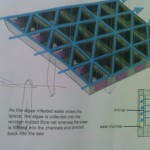
Andreas Poullaides
Already focus on Simrishamn as a site, not looked at Israel at all.
Site studies are looking at complete Baltic, if this overall statistics is available, it should be used carefully since the exact site is already used (Simrishamn). Israel should be considered initially, to bring similar issues as in Simrishamn approach, but what is different? Where does the algae go later? Blue green algae can be processed to get hydrogen, which could be used to get buoyancy for floating structure? Parallel study of thin membrane surfaces hardened through plaster and reinforcement?
– Separate scales of components: triangular small scale with filter performance, large scale beam creating structural grid.
– Build the design around the lifecycle of the algae.
– Push loose relationship between different material systems, and push the architectural performance (spatial, climate control, structure, program)
– Consider an initial approach for Israel.
– Develop layout, better graphics; organize how material is being communicated. Graphic consistency, emphasis of material, and color coding.
Parametric potential
Andreas suggested a third system on Friday; a banded /woven principle combined with almost hexagonal components. He must now focus and develop the ones he has suggested, rather than look for additional one, so GC could be helpful here. Include parametric approach in design research statement.GC models could explore the following (choosing one to start):
– In triangulated filter component system, the local deformation of components in relation to overall deformation of system; some parts of the filter mechanisms may be standardized, other simpler parts may be mass customized .
– New weaving system may have different inserted components (such as storage containers for algae, filter mechanisms or buoyancy elements), A GC model may therefore set up a general superstructure that can carry different variants of components. Also, the formal differentiation of banding could be explored (bands could differentiate in width and thickness depending on their location in structure).
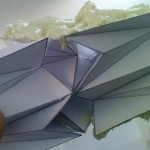
Chi Sung Lee
New version of component with deeper angels, and smaller aperture.
Model in paper with inserted insulation. What is the acoustic difference with a scale shift from 1:1 to 1:1,5. Probably good to go up on component size. In general well produced drawings and a new step forward in the development.
– Design of joints is also part of fabrication, assembly, structure and aesthetic performance.
– Make different iterations/versions with different materials for different purpose. Explore rigorously these potentials.
– Deliver before going to Israel
Parametric potential
Base GC model on triangular grid. There are several options for surfaces defining the grid, discussed already in tutorial on Friday.
– One surface with differentiation in thickness + component variation controlled by two separate control surfaces. The attaching triangles connecting the components would be on this surface, located more or less in the central of the component.
– Two surfaces controlling each end of the components (deep component principle). Drawback is that it is difficult to place attaching triangles in center, must be on either surface.
– Combination of the two; center of component and one surface are defined by surfaces, other side is controlled by separate control surface.
Separate fabrication model will be necessary to make for each component, in which the triangular basis may be questioned; see the Emergent / Dragonfly project.
In addition, the definition of the overall form should be studied; make sure that the GC investigations are not only showing that different thicknesses and aperture effects can be achieved, but also look at how the system connects with different floors, changes from locations (wall/floor/ceiling/roof) and attaches to ground. Include parametric approach in design research statement.
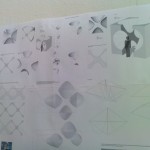
Maryam Pousti
Using the slumped plastic materials as a formwork for concrete or other material. Combination of plastic set in frames (as before) and cast material in the form. Two scales at this point; 1. Casts the size of concrete prefab slabs. 2. Slumped plastic parts in small component scale. Is the second the aim architecturally/effect wise, to be achieved by the first? Translucency/transparency? Fabrication process that allows good control? Visual quality rather than geometry. Decision should be made on scale of component. Site Istanbul.
– Thickness in relation to architectural effect rather than the structural performance.
– Soft mould that is injected with casting material?
– Abstract site issues must be defined.
Parametric potential
Simulations of small scale component can be done by using population principle, either with single or double surface. Separate control surfaces or gravity may define angle of slumping, as discussed on Friday. Careful study of the geometrical definition of the component must be made; the approximation in Rhino with a revolving surface does not fully show the variations in form achieved in physical models. An alternate scenario would be to use the solid massing principles shown by Gustav. Include parametric approach in design research statement.
Sakiko Watanabe
Section drawing A3. No A1 drawing. Site / Simrishamn. Dew condensation / water. Greenhouse. How does the fabrication relate to condensation aspects? What materials can aid condensation? Transparent material needed for greenhouse.
Key interests: densities, cuts controlling heights and density differentiation.
– Greenhouse in Tel Aviv, Research facility in Simrishamn?
– Must consolidate material and ideas, join ideas around light, condensation, spatial principles and fabrication.
– What are the qualities of the system? Needs to be revisited! Also materials!
– Interest in urban agriculture, possibility in growing plants not possible to grow before. Too narrow…
– Should look more at marine research centers in Baltic.
– Look for more opportunities in system.
– Two story potential, vertical configuration.
– Can double skin configuration allow air to flow through, inducing condensation.
– Work in drawings. Think additional materials.
– GC should be used as 2D pattern at this point.
Parametric potential
Complete model of the folding principle is very difficult to achieve and would depend on reverse engineering the geometrical principle at a very advanced level. More fruitful at this stage would be to set up 2D patterns that allow further exploration of the formal variation, with more intricacy than before (as suggested by Andrew at tutorial). After this, another model may schematically study the overall form, showing the thickness variation and material contraction (as each sheet is deformed when being folded) in estimation, to allow for a larger scale of design. Include parametric approach in design research statement.
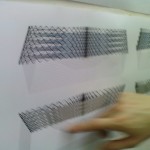
Kengo Skorick
Scripted variation of system, drawings as catalogue showing deformation according controlled parameters. Abstract spatial configuration of two stories separated climate wise, and structure/framework controlling airflow through (differentiation of density). No site aspects included yet.
Kengo depends on scripted performance in order to move on, must also be able to formulate ambition architecturally. Will visit 3d weaving facilities in Israel.
– Define architectural performance for different variation. Explain more than formal principles and technical functions.
– Use designed shutters rather than flexible material for climate control?
– Use of fabrics as composite material itself?
– Can a vertical / wall figuration also be deployed?
– Find abstract site conditions to inform system.
– Work spatially with system?
– Work with different media continuously, not only completely scripted/GC models.
– Fabrication casts are being produced (cnc milled form)
Parametric potential
CH model may schematically study deformation and apertures, rather than fully show the deformation of each component. The system could here be defined though two surfaces or solids, the deformation would be based on findings in the physical models and the scripted digital models. This would be done in parallel to further investigations of the deformation of the detailed parts. When designing the structure, GC would at detailed level allow a more exact definition of what parts are being deformed and what are static.
Include parametric approach in design research statement.
Arya Safavi
A1 of references in fabrication. GC modeling. Looking at carbon fiber, fabrication of joints. Preparing GC parameters, in need to get a functional model. Model presented at crit is 1:1.
– Consider other fabrication, such as injection molding or extrusion.
– Building skin scale – flexible, dynamic skin.
– Operates as a surface that expands and contracts.
– What it generate spatially? Shadow quality.
– Mechanical behavior mimicking material performance.
– Fragmented over a bugger surface, rather than continuous.
– Think carefully about scale, and architectural performance, suggest variants, so we can discuss appropriate fabrication, production and material usage.
Parametric potential
Try to simulate the auxetic principles through understanding the geometrical principles behind it, but also do larger scale models that are looking at the architectural behavior of system, in which the auxetic deformation is only presented in an abstract way. It is crucial to define and understand the effect of expansion / contraction locally / globally spatial and other architectural conditions.
Include parametric approach in design research statement.
Jung Joon Yun
Dropped the weaving principle. No A1 drawing. Channeling. Looking into fabrication. Low energy cooling system. Private / public relations.
– Where is the architectural scale? What is the architectural ambition? What is left after wind is removed?
– What is the potential of porosity besides wind?
– Reconsider scale. Spatial qualities should be explored.
– Revise design research agenda.
– Produce more material!
Parametric potential
After setting scale, GC can be used to study material system more closely, including the different parts of components (panels? Cast material?). Focus on the architectural effect rather than how air flows only. Make sure to consider several materials at the same time. Fabrication models may be needed to be developed in parallel, regardless if parts are to be cast or produced through cutting and forming of panels.
Include parametric approach in design research statement.
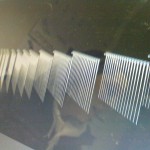
Claudia White
Elaborated physical models (only shown as images, no models brought in). Looked at underwater turbines. Power generated to the research center. Currently developed as technical system, not yet considered how underwater experience can be achieved. Mechanical scale model simulating overall system behavior. Wants to work in Corian. Components ½ meter – 1 meter.
Discussing the performance out of aspects of effects, yet the actual access for visitors is not there.
Rhino scripting simulating tidal movement.
– Should focus on relation between submerged environment, floating parts and mainland parts.
– What are the differences when deployed in Tel Aviv and Simrishamn?
– Look at fabrication at different scale; project is working at similar to urban scale.
Parametric potential
GC may be used at a large scale study (as the three parts meet; on land, floating and submerged). Make sure not to only model the so far purely technical and formal submerged components, but also how they relate to architectural aspects. Fabrication principles should be regarded; what kind of instructions are necessary to fabricate and later mass produce the parts?
Include parametric approach in design research statement.
Sharon Toong
Looking at clam shells for minimum drag situation. Using hydrogel again, to differentiate surface, for temperature control. Water collection, essential part of making the system work, more visible. Public areas with water accumulation. No absorption of salt water. Evaporation time? Wind working with form to cool down and push evaporation.
– Add experiential effects
– Structure?
– Relation to sea water.
– Geodesic structures, reference bucky fuller.
– All aspects are now based on the performance of hydrogel, what are the other aspects??!
Parametric potential
GC model must be based on a defined structural system (geodesic or something else?), and should explore the architectural performance of the space (it cannot only be a dome). After this, the principle for component deformation should be looked at. Avoid making the system depend on the material performance of hydrogel, or even on mechanical principles of opening/closing water collection units; the design must be driven by the spatial qualities desired, the technical performance must be secondary. Include parametric approach in design research statement.
Michal Clormek
Wants to integrate different systems into a framework. Looking at the BMW GINA conceptual project.
– Is the architectural equivalence a tent..?
– A lot of parallel work is needed; architectural performance, fabrication, structure, climate.
– Look immediately into compositing with several different systems.
– Geometry must be developed from scratch.
– Start from drawing.
– Material, framework, geometry, performance.
Parametric potential
Find a way to use splines or other controlling geometries that can be coupled to material performance of structural system (analogous to the BMW GINA set up). Define how surfaces will be deformed in different situations. Make sure to use GC to explore possible architectural effects of this material system, and study patterns for textiles and clothes in order to understand what kind of fabrication drawings will be necessary for skin. The choice of structural material will be crucial when defining fabrication principles for structure (consider materials other than carbon fiber). Include parametric approach in design research statement.
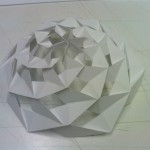
Kyu Dong Jung
Presenting material references then geometry. Drawing showing hexagonal components based on spiral, originally based on Fibonacci series. Considered to be “component” scale of ca 1 meter. Wants to use super absorbent polymer to control apertures (?). Very vague on architectural ambition.
– Starting from scratch, what do you want to do? Moving not essential. Cheap materials combined in different ways interesting (OMA Kunsthalle). Dip16 is really quite similar. OMA organizes projects and also organizes materials.
– No research statement so far. Focus on regulating temperature in building.
– Clarify research statement for Friday to be discussed with JL.
Parametric potential
Define a material system based on the studies of Fibonacci variations of domes, but applied to other overall geometries as discussed in tutorial. When appropriate architectural effect (not the opening/closing of apertures but rather overall geometry and light and formal principles) have been defined, set up GC model with fabrication links that allows further studies and fabrication of physical models (may be based on planar panel element as the current models, or other principle, but make sure to set materials and integrate ideas of fabrication and assembly). Avoid making system depend conceptually on the mechanical deformation (opening/closing) using the hydrogel, this should be secondary. Include parametric approach in design research statement.
Michael Kloihofer
No printed A1, but digital 2 A1s.
Structure was weaving initially, using an inflated fabric with pockets as jig, formwork and vital part of system. Architectural effect of transition of water simulated in renderings/animations.
– Do 2nd floor
– Issue of actuators
– Fabrication issues of structure must be tested.
Parametric potential
Consider formal variations of structural system and water carrying system, not in the sense of dynamic change, but rather as variations in different parts of system (when close to ground, as wall, horizontal/vertical configuration etc). There are great potential is setting up GC models with relations to fabrication principles, both of the structural system and the water carrying system. The hierarchies between the two should be considered (which one directs the other one in a digital model?). The structural system needs to be deifned more carefully before, and the water carrying system needs to consider expansion of material before appropriate fabrication drawings may be designed. Include parametric approach in design research statement.
Leave a Reply